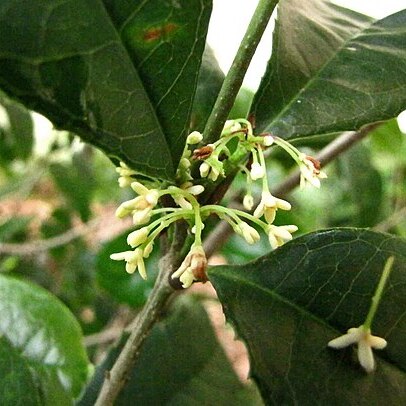Trees or shrubs, at least two spp. laticiferous. Leaves simple, entire, subopposite or opposite, rarely subverticillate; often with some alternate ones between, penni-nerved; petiole sometimes with auricles at the top; blade often with glandular pits in the axils of the secondary nerves or scattered on the undersurface; tertiary nerves slender but conspicuous, transverse and usually crowded, more or less perpendicular to the midrib. Stipules small, caducous. Flowers bisexual, in small fascicles or solitary, placed along racemose or more or less broadly paniculate axillary shoots; bracts minute deltoid. Sepals 5, quincuncially imbricate, two inner ones with scarious margins. Corolla infundibuliform, tube short, slightly thickened; lobes spreading, imbricate in bud. Staminodes 5, alternipetalous, inserted in the throat. Stamens 5, epipetalous; filaments short, connate with the base of the petals; anthers basifix, slightly extrorse, 2-celled, longitudinally dehiscent. Ovary superior, 1-2-celled, glabrous, contracted into a short stout style; cells with 1 apotro-pous, ascending ovule, attached to the basis of the central axis; stigma truncate, capitate or faintly 2-lobed. Fruit drupaceous, 1-(2)-seeded, ovoid to oblong; pericarp thin. Seeds with a thin-crustaceous pale dull testa. Hilum small, round, basal; albumen absent; cotyledons thick; radicle inferior.
More
Evergreen trees. Leaves opposite, subopposite, or rarely spirally arranged; stipules small and early deciduous with conspicuous scars on petiole, sometimes subpersistent; leaf blade almost leathery. Flowers small, solitary or clustered on axillary racemes or panicles; bracts small, triangular. Sepals 5, rounded, imbricate. Corolla broadly campanulate; lobes 5, ovate. Stamens 5, inserted on corolla tube and opposite lobes; staminodes 5, subulate to triangular, inserted in throat and alternating with corolla lobes. Ovary 1-or 2-locular, glabrous. Style short; stigma 2-lobed. Fruit a drupe, ellipsoid; pericarp very thin and mealy; 1-or 2-seeded. Seed scar small, rounded.

